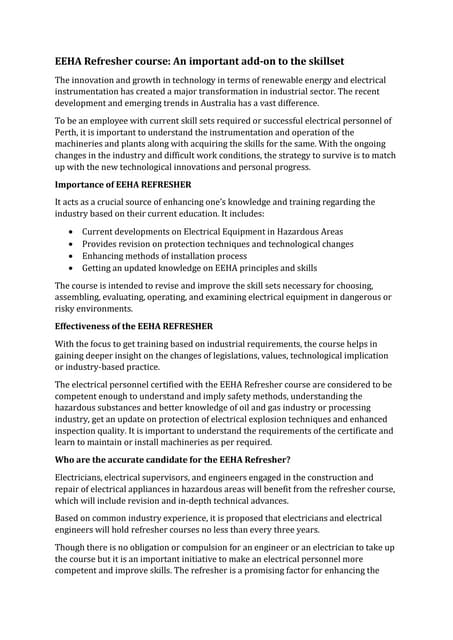How Roar Solutions can Save You Time, Stress, and Money.
How Roar Solutions can Save You Time, Stress, and Money.
Blog Article
Roar Solutions - Truths
Table of Contents8 Easy Facts About Roar Solutions DescribedThe Best Guide To Roar SolutionsSome Ideas on Roar Solutions You Should Know
In order to safeguard setups from a potential surge a technique of analysing and categorizing a potentially hazardous location is required. The objective of this is to make sure the proper selection and setup of tools to inevitably stop a surge and to make certain safety and security of life.
(https://roarsolutions.mystrikingly.com/blog/master-emergency-response-with-roar-training-solutions-and-eeha-courses)
No equipment ought to be set up where the surface area temperature of the devices is higher than the ignition temperature level of the offered danger. Below are some usual dust dangerous and their minimum ignition temperature level. Coal Dirt 380C 225C Polythene 420C (thaws) Methyl Cellulose 420C 320C Starch 460C 435C Flour 490C 340C Sugar 490C 460C Grain Dust 510C 300C Phenolic Material 530C > 450C Aluminium 590C > 450C PVC 700C > 450C Residue 810C 570C The chance of the hazard existing in a focus high adequate to cause an ignition will certainly differ from location to location.
In order to classify this danger a setup is split into areas of risk relying on the quantity of time the hazardous exists. These areas are described as Zones. For gases and vapours and dirts and fibres there are 3 zones. Area 0 Area 20 A harmful environment is extremely likely to be present and may exist for lengthy durations of time (> 1000 hours each year) or even continually Zone 1 Zone 21 A hazardous ambience is possible but unlikely to be existing for extended periods of time (> 10 450 C [842 F] A category of T6 suggests the minimum ignition temperature level is > 85 C [185 F] Dangerous location electric tools perhaps created for usage in higher ambient temperature levels. This would showed on the ranking plate e.g. EExe II C T3 Ta + 60C( This means at 60C ambient T3 will not be gone beyond) T1 T1, T2, T3, T4, T5, T6 T2 T2, T3, T4, T5, T6 T3 T3, T4, T5, T6 T4 T4, T5, T6 T5 T5, T6 T6 T6 A T Course rating of T1 suggests the optimum surface temperature level created by the tool at 40 C is 450 C. Presuming the associated T Class and Temperature score for the equipment are proper for the area, you can always make use of an instrument with a more stringent Department rating than needed for the area. There isn't a clear response to this concern. It actually does rely on the type of devices and what fixings require to be accomplished. Tools with certain examination treatments that can't be executed in the area in order to achieve/maintain 3rd party rating. Should return to the factory if it is before the equipment's solution. Area Repair By Authorised Employee: Difficult testing may not be called for however details procedures may need to be followed in order for image source the devices to preserve its 3rd party rating. Authorized employees must be utilized to execute the work appropriately Fixing must be a like for like substitute. New part have to be considered as a direct replacement needing no unique testing of the devices after the repair service is complete. Each piece of devices with a harmful score ought to be assessed individually. These are laid out at a high degree below, but for even more thorough info, please refer directly to the standards.
The Definitive Guide to Roar Solutions
The tools register is an extensive database of tools documents that consists of a minimum set of fields to recognize each item's location, technical specifications, Ex-spouse classification, age, and environmental information. The proportion of In-depth to Close assessments will certainly be identified by the Devices Danger, which is examined based on ignition risk (the probability of a source of ignition versus the likelihood of a flammable atmosphere )and the unsafe area classification
( Zone 0Area 1, or 2). Implementing a robust Risk-Based Evaluation( RBI )approach is essential for making sure conformity and safety in taking care of Electric Devices in Hazardous Areas( EEHA).
The Definitive Guide for Roar Solutions

In regards to explosive danger, a dangerous area is an environment in which an eruptive atmosphere exists (or may be anticipated to be existing) in quantities that need special preventative measures for the building and construction, installment and use tools. hazardous area course. In this post we explore the difficulties encountered in the office, the risk control measures, and the required proficiencies to work safely
It is an effect of modern life that we produce, store or manage a variety of gases or liquids that are deemed combustible, and a series of dusts that are regarded combustible. These compounds can, in specific problems, form explosive atmospheres and these can have major and awful consequences. Many of us are familiar with the fire triangular get rid of any one of the three elements and the fire can not occur, but what does this mean in the context of unsafe locations? When breaking this down into its simplest terms it is basically: a mix of a specific amount of launch or leak of a specific compound or material, combining with ambient oxygen, and the existence of a source of ignition.
In a lot of circumstances, we can do little regarding the levels of oxygen in the air, however we can have substantial impact on resources of ignition, as an example electric devices. Dangerous locations are documented on the unsafe area category illustration and are determined on-site by the triangular "EX-SPOUSE" indication. Right here, amongst other crucial details, areas are split into 3 types relying on the danger, the probability and period that an eruptive ambience will exist; Zone 0 or 20 is considered one of the most unsafe and Area 2 or 22 is considered the least.
Report this page